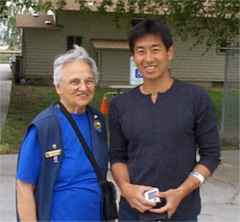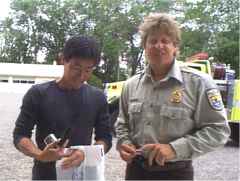JAPANESE WORK ON CONSERVATION
|
In Japan Non-governmental Organizations (NGO) are looking to conservation of the environment. On May 31, 2005, Hideo Nakashima visited the McNary National Wildlife Refuge to learn how the United States practices conservation. John Gahr, McNary Refuge manager, explained how the Refuge operates and asked me to describe the Environmental Education Program. I think Hideo got information overload. He does not speak very much English but I have no idea how much he comprehends of what he hears. I know from listening to other languages I cannot keep up with the thoughts. Our education program reaches thousands of school children each year. Teachers reserve a day to bring their classes for hands-on learning experiences with plants and animals - the main categories of living things. It is easy to understand that we eat mostly plants because they are rooted and can't run away, no weapons required for capture. The vertebrate learning experience takes place in the display room where the artificial eyes of over 70 mounted bird specimens look down at the kids. Identifying the birds is very interesting because although the children may have seen some of the birds flying, never have the birds stood still for close examination. Differences in beaks range from the long narrow mud prober of the curlew to the short sharp meat ripping beak of the juvenile bald eagle. The mounted birds cannot be touched, but there are feathers, talons, beaks and bones for touching. Pelts of beaver, coyote, skunk, racoon, and otter are there for stroking. Plants are touched, smelled, and examined in the native plant plot as the guide walks the group toward the pond. At our 'stumphenge' (a cluster of large stumps) children find tiny animals under the leaves and in the soil illustrating connections of plants to habitats. They see flowers disected and differences in leaves under microscopes. Differences are noted in the lives of plants - rosettes, stems, flowers, and seeds are examined in season. The water habitat and desert habitat show off their respective plants and we talk about root systems that thrive in each. Invertebrates are taken from the pond water and mud, separated with probes by the children and examined under microscopes. How exciting to examine a worm and be told that it is the mid life of the midge flies flitting all around us! Damsel fly nymphs are delicate beautiful creatures as are many other 'critters' the children discover wiggling in the mud. The tule-mat teepee is the place to learn how Native peoples lived with nature. The bird blind allows observing birds without being seen by them. Muskrats, fish, turtles, and bullfrogs are often observed there, too.
|
Consider novels by Naomi Sherer available on Amazon


Coming Soon: Beyond Namche, The Open Door, Wildly in the Rockies


